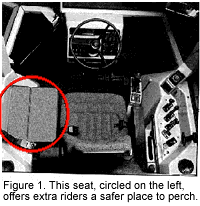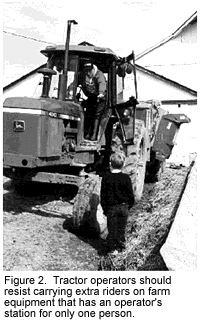The idea of carrying extra riders on farm equipment is controversial. There are safety risks. Even so, the practice is common and deeply embedded within farming's heritage. Recently, farm equipment manufacturers have begun installing passenger seats on some farm machinery; most notably tractors and self-propelled machines like combines and forage harvesters. Providing a passenger seat on farm machinery responds to farmers who choose not to follow the recommended safety practice of permitting n one but the operator on the machine. This fact sheet examines the extra rider issue.
Extra Rider Injury Victims
| Table 1. Pennsylvania extra rider fatalities by age groups. (1983-1993) | ||
| Age of Victim | Number of Fatalities | Male/Female Ratio | 0-4 years | 5 | 4/1 | 5-9 years | 8 | 7/1 | 10-14 years | 4 | 4/0 | 15+ years | 3 | 3/0 | TOTAL | 20 | 18/2 |
The majority
of extra rider victims in Pennsylvania are young children. This
is one reason why a discussion of this topic is often emotionally
charged. In Pennsylvania between 1983 and 1993, there were 20
extra rider fatalities--17 involving children 14 years of age
and under, with the youngest victim just one year old. Children
between five and nine were the age group with the highest number
of fatal injuries. In this age group are children who are: developing
their motor skills; curious about operating machinery; and desire
to be with adults. At this age, many parents feel that their
child is now old enough to help with certain chores, and to
ride on and/or operate farm equipment. Table 1 illustrates that
young boys represent the majority of victims in extra rider
injury incidents in Pennsylvania.
Extra Riders: A Cultural Tradition
In recent years, researchers have documented the frequency of young extra riders on farm machinery. For example, in 1989 Successful Farming magazine surveyed randomly selected farm parents with children 15 years of age or younger. Ninety-five percent of the respondents indicated that their children were riding tractors by ages 7-9, and that parents generally considered this a low risk activity. This survey documents what is easily observed and informally discussed when farm families meet and child safety is discussed. Photos in magazines and newspapers, which reflect intimate moments of farm life, often portray an idyllic scenario of father and son forming the bonds that keep America's esteemed agrarian traditions alive. Conversations among farm reared adults are often peppered with boasts of how young they were when they first began riding on or operating farm tractors and other machinery. It is easy to imagine that every adult farmer has been an extra rider on a tractor or other machine during his or her arming career.
Incidences of riding extra on a tractor or other farm machinery may occur a dozen times during a typical work day or week and become as routine as daily livestock chores. Riding extra on a tractor or other farm equipment may not result in an injurious or unwanted event. In fact, just the opposite normally occurs: work is completed more quickly or conveniently; needed transportation is provided; job training is accomplished; or a babysitting problem is resolved. Thus, riding extra may be practiced at a young age, become deeply ingrained, and be passed on from generation to generation.
A Passenger Seat on Farm Machinery?
There
is no simple answer on whether a passenger seat is a less
risky alternative for extra riders. Currently, U.S. manufacturers
add a passenger seat on some tractors, combines and forage
harvesters with enclosed cabs only. Tractors have ROPS (Rollover
Protective Structure) with seatbelts. Self-propelled machines
have cabs without ROPS. The following discussion incorporates
information from an agricultural safety and health task force
who discussed the pros and cons of a passenger seat on tractors with ROPS cabs. This information is presented to inform
and also to encourage public debate on this issue. Though
the information refers to tractors, much of the discussion
is also pertinent to combines and other self-propelled farm
machinery. 
Reasons Supporting a Passenger Seat As noted earlier, the reasons for carrying extra riders are numerous and deeply embedded within the culture of farming. Among the reasons identified by agricultural safety professionals are that it:
Not everyone agrees that these are sufficient reasons. Since most tractor operators have reasons for carrying or being an extra rider, an extra seat can be said to increase passenger safety for several reasons, including:
Additionally, it is arguable that a passenger seat: is possible because tractors in Europe have had them for many years without known adverse consequences; and is consistent with safety engineering principles. For example, provision of a passenger seat is compatible with the human factors engineering principle of adapting the working environment to accommodate the worker, rather than changing the work practices of the worker. And a passenger seat is consistent with the safety hierarchy for addressing risks. The safety hierarchy suggests that it is more effective to provide safety engineering solutions (a passenger seat with seat belt inside of a ROPS cab) for risks rather than rely upon safety warnings or instruction (e.g. No Extra Riders!).
Reasons
Opposing Passenger Seats
While
there are good reasons for providing a passenger seat with
seatbelt, there are also compelling reasons why this is less
than desirable. Major concerns include overuse of a passenger
seat and increased opportunity for injury. Concerns are that
a passenger seat will:
A fundamental safety principle is that any engineering change should not increase a person's risk of injury. Several of the concerns above can result in an increased exposure to hazards and possible injury to a passenger and/or operator. Additionally, a passenger seat may encourage two-person operations of farm machinery and increase risk-taking during machinery malfunctions, adjustments or servicing.
Miscommunication between an operator and passenger could also have a tragic ending.
Another problem is the lack of existing standards to guide the development, installation and use of passenger seats. An accepted passenger seat safety standard may be years away--if one is ever approved--because of the issues surrounding the idea. A safety standard helps to develop consensus on important design features. For example, should passenger seats be: designed ergonomically for long-term riders; designed to discourage long-term riding; engineered for equal "zones of protection" for ri ers and operators; designed for all populations or more specifically for children because they are the primary extra riders? The answers to these questions are important to: the costs associated with redesigning farm machinery; work safety recommendations; and liability issues for manufacturers, employers and workers.
The Practice of Riding Extra
There are many ways to reduce the need to carry an extra rider. Advanced planning of work tasks, using safety management techniques to reduce hazards, alternative forms of transportation, and changing job assignments are some ways to reduce the need to carry an extra rider. Nevertheless, the practice of riding extra is likely to continue.
 Riding as a passenger does involve risk for a permanent or
fatal injury, but the same can be said about office work,
recreational activities, or even taking a shower. Some risk
is always present in nearly all daily activities. To avoid
injury is to minimize the chances that an unwanted incident
will occur, or if it does, how to minimize its most serious
consequences. For example, on tractors without trailing equipment,
risk is lowered by riding at the rear of the tractor rather
than on the rear wheel fender or rear axle. This reduces, but
does not eliminate, the chance of being thrown under the tractor's
wheels.
Riding as a passenger does involve risk for a permanent or
fatal injury, but the same can be said about office work,
recreational activities, or even taking a shower. Some risk
is always present in nearly all daily activities. To avoid
injury is to minimize the chances that an unwanted incident
will occur, or if it does, how to minimize its most serious
consequences. For example, on tractors without trailing equipment,
risk is lowered by riding at the rear of the tractor rather
than on the rear wheel fender or rear axle. This reduces, but
does not eliminate, the chance of being thrown under the tractor's
wheels.
The rest of this section addresses how to minimize the hazard and risk of carrying or being an extra rider.
Training New Machinery Operators The training of new operators of tractors, combines, or other self-propelled machinery is one instance where an extra rider may be justified. The size and complexity of some modern machines make static and ground-based instruction less than satisfactory from an instructional perspective. On equipment with a ROPS cab, the instructor should be inside the cab with the door and cab windows closed. On equipment with a passenger seat and seatbelt, the instructor should be seated and belted.
Most training can be conducted with the instructor on the ground and the trainee in the operator's station. The trainee should first be taught how to safely start and turn off the machine, engage and disengage the clutch, and locate the primary controls such as the brakes, PTO and hydraulics. Training should then be done at a slow, carefully controlled speed while on level, solid ground. Other equipment or machinery should not be attached and the training session should be:
These conditions allow a training instructor to walk safely beside or behind a moving machine and to use hand signals to communicate with the trainee. Suggestions for starting and stopping farm machinery safely, and on agricultural hand signals, are available from a variety of sources, including operator's manuals, extension bulletins and other training resources. Contact your equipment dealer or county extension agent to obtain these materials. It is also crucial that instructors use good instructional methods during training.
Riding Extra on Farm Machinery Extra rider safety usually focuses on tractor operations, but riding on loaded or empty wagons and other pulled or attached machinery is also an issue. This practice, too, is likely to continue though it usually is unnecessary and could be avoided with advance planning. The specific locations and circumstances for riding extra on farm machinery and equipment are nearly endless. Nevertheless, some scenarios are more common than others. Suggestions for reducing risk for common situations can be applied to less common situations. Risks for extra riders can be reduced by: starting and stopping smoothly; using slower speeds while towing or turning; going slowly over rough terrain; and avoiding bumps and other obstructions. Extra riders can enhance their safety by sitting whenever possible and by wearing shoes with nonskid soles. Passengers on self-propelled machines can reduce risk by riding on machinery with enclosed cabs, with all doors and windows closed. The risk to extra riders increases when a tractor or self-propelled machine is towing other equipment.
A Final Comment
The idea that an extra rider on farm machinery can be carried safely is controversial. It is a highly emotional issue, especially when focusing on children and their safety. Some of the underlying factors are: developmentally appropriate farm work tasks for children; parenting and babysitting options for farm families; the economic necessity of child labor; and agricultural heritage and farming lifestyles. Each of these topics can generate controversy among farm families, safety and health professionals, government regulators and the public. Less debatable is a need to reduce injuries to all persons living, working and visiting on farms. Following the safety practice of not allowing an extra rider is one way to achieve this goal.
Sources Cited
Dennis J. Murphy, Professor, Agricultural Engineering; Sam Steel, Sr. Research Technologist, Agricultural Engineering
Agricultural
and Biological Engineering Extension
246 Agricultural Engineering Building
Penn State University
University Park, PA 16802
Telephone: 814-865-7685
FAX 814-863-1031
Disclaimer and Reproduction Information: Information in NASD does not represent NIOSH policy. Information included in NASD appears by permission of the author and/or copyright holder. More